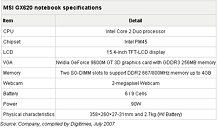
Intel Tables Plans to Tackle Notebook and Netbook Markets in H2 2009
Intel has everything going its way when it comes to mobile computing, and the processors it sells that power notebooks and netbooks across every segment of the market. Intel uses the common classification of portable computers (consumer segment), using sizes and form-factors to differentiate mainstream notebooks, performance notebooks, ultra-thin notebooks, "larger" sub-notebooks (netbooks), and common entry-level netbooks. To cater to each of these, Intel made things easier by coming up with platforms (sets of processor and chipset combinations), a market approach both Intel and AMD have been using recently.
Starting with mainstream, and performance notebooks (traditionally above 14-inches in size, above US $1200 in price), Intel has the Calpella platform, that marks the entry of Nehalem architecture to the mobile scene. This is slated for 3Q 2009. Intel will simultaneously lower the prices of its current Montevina platform, to let inventories digest. Major hardware manufacturers are preparing their "launch-vehicles" for the Calpella platform, which will make it in time for Q3 2009.
Starting with mainstream, and performance notebooks (traditionally above 14-inches in size, above US $1200 in price), Intel has the Calpella platform, that marks the entry of Nehalem architecture to the mobile scene. This is slated for 3Q 2009. Intel will simultaneously lower the prices of its current Montevina platform, to let inventories digest. Major hardware manufacturers are preparing their "launch-vehicles" for the Calpella platform, which will make it in time for Q3 2009.






